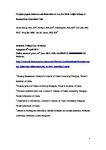Oropharyngeal Colostrum Administration in Very Low Birth Weight Infants
| dc.contributor.author | Zhang, Y | |
| dc.contributor.author | Ji, F | |
| dc.contributor.author | Hu, X | |
| dc.contributor.author | Cao, Y | |
| dc.contributor.author | Latour, Jos M | |
| dc.date.accessioned | 2017-07-06T07:07:32Z | |
| dc.date.available | 2017-07-06T07:07:32Z | |
| dc.date.issued | 2017-06-14 | |
| dc.identifier.issn | 1529-7535 | |
| dc.identifier.issn | 1947-3893 | |
| dc.identifier.uri | http://hdl.handle.net/10026.1/9595 | |
| dc.description | Publisher policy: author can archive post-print on institutional repository after 12 months embargo. Publisher's version/PDF cannot be used. Must include statement that it is not the final published version. Published source must be acknowledged with full citation. Must link to publisher version | |
| dc.description.abstract |
<jats:sec> <jats:title>Objectives:</jats:title> <jats:p>Studies have confirmed the safety of oropharyngeal administration of colostrum in very low birth weight infants. However, the effect of oropharyngeal administration of colostrum on immune system is inconclusive. This study aims to evaluate the effect of oropharyngeal administration of colostrum on secretory immunoglobulin A and lactoferrin in very low birth weight infants.</jats:p> </jats:sec> <jats:sec> <jats:title>Design:</jats:title> <jats:p>Randomized controlled trial.</jats:p> </jats:sec> <jats:sec> <jats:title>Setting:</jats:title> <jats:p>Forty-bedded neonatal ICU in a university children’s hospital in the People’s Republic of China.</jats:p> </jats:sec> <jats:sec> <jats:title>Patients:</jats:title> <jats:p>Very low birth weight infants were allocated to the study group (<jats:italic toggle="yes">n</jats:italic> = 32) and control group (<jats:italic toggle="yes">n</jats:italic> = 32).</jats:p> </jats:sec> <jats:sec> <jats:title>Intervention:</jats:title> <jats:p>The intervention was oropharyngeal administration of 0.2 mL of their mother’s colostrum every 4 hours for 7 days. The control group received saline solution.</jats:p> </jats:sec> <jats:sec> <jats:title>Measurements and Main Results:</jats:title> <jats:p>Secretory immunoglobulin A and lactoferrin in urine and saliva were measured within 24 hours of life (baseline) and at 7 and 21 days. Primary outcomes were changes of secretory immunoglobulin A and lactoferrin in urine and saliva between baseline and at 7 and 21 days. Infant’s clinical data were also collected during hospitalization. Change from baseline in lactoferrin in saliva at 7 days (5.18 ± 7.07 vs –1.74 ± 4.67 µg/mL; <jats:italic toggle="yes">p</jats:italic> < 0.001) and 21 days (5.31 ± 9.74 vs –1.17 ± 10.38 µg/mL; <jats:italic toggle="yes">p</jats:italic> = 0.02) shows statistic difference. No differences were found of lactoferrin in urine and also no differences of secretory immunoglobulin A in urine and saliva. There were also no differences between days to full enteral feeding, occurrence rate of clinical sepsis, proven sepsis, and necrotizing enterocolitis.</jats:p> </jats:sec> <jats:sec> <jats:title>Conclusions:</jats:title> <jats:p>Oropharyngeal administration of colostrum can increases the level of lactoferrin in saliva in very low birth weight infants. No effect could be documented of secretory immunoglobulin A and lactoferrin in urine. Larger trials are needed to better describe the benefit of oropharyngeal administration of colostrum, if any, in very low birth weight infants.</jats:p> </jats:sec> | |
| dc.format.extent | 1-1 | |
| dc.format.medium | ||
| dc.language | en | |
| dc.language.iso | en | |
| dc.publisher | Ovid Technologies (Wolters Kluwer Health) | |
| dc.subject | feeding methods | |
| dc.subject | immunotherapy | |
| dc.subject | infection | |
| dc.subject | neonatology | |
| dc.subject | premature infants | |
| dc.title | Oropharyngeal Colostrum Administration in Very Low Birth Weight Infants | |
| dc.type | journal-article | |
| dc.type | Journal Article | |
| dc.type | Randomized Controlled Trial | |
| plymouth.author-url | https://www.webofscience.com/api/gateway?GWVersion=2&SrcApp=PARTNER_APP&SrcAuth=LinksAMR&KeyUT=WOS:000408818800013&DestLinkType=FullRecord&DestApp=ALL_WOS&UsrCustomerID=11bb513d99f797142bcfeffcc58ea008 | |
| plymouth.issue | 9 | |
| plymouth.volume | 18 | |
| plymouth.publication-status | Published | |
| plymouth.journal | Pediatric Critical Care Medicine | |
| dc.identifier.doi | 10.1097/PCC.0000000000001221 | |
| plymouth.organisational-group | /Plymouth | |
| plymouth.organisational-group | /Plymouth/Faculty of Health | |
| plymouth.organisational-group | /Plymouth/Faculty of Health/School of Nursing and Midwifery | |
| plymouth.organisational-group | /Plymouth/REF 2021 Researchers by UoA | |
| plymouth.organisational-group | /Plymouth/REF 2021 Researchers by UoA/UoA03 Allied Health Professions, Dentistry, Nursing and Pharmacy | |
| plymouth.organisational-group | /Plymouth/Research Groups | |
| plymouth.organisational-group | /Plymouth/Research Groups/Institute of Health and Community | |
| plymouth.organisational-group | /Plymouth/Research Groups/Plymouth Institute of Health and Care Research (PIHR) | |
| plymouth.organisational-group | /Plymouth/Users by role | |
| plymouth.organisational-group | /Plymouth/Users by role/Academics | |
| dc.publisher.place | United States | |
| dcterms.dateAccepted | 2017-04-05 | |
| dc.rights.embargodate | 2018-6-14 | |
| dc.identifier.eissn | 1947-3893 | |
| dc.rights.embargoperiod | 12 months | |
| rioxxterms.versionofrecord | 10.1097/PCC.0000000000001221 | |
| rioxxterms.licenseref.uri | http://www.rioxx.net/licenses/under-embargo-all-rights-reserved | |
| rioxxterms.licenseref.startdate | 2017-06-14 | |
| rioxxterms.type | Journal Article/Review |


